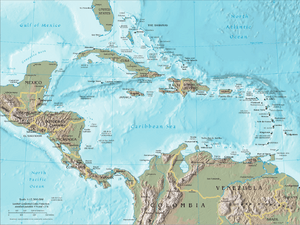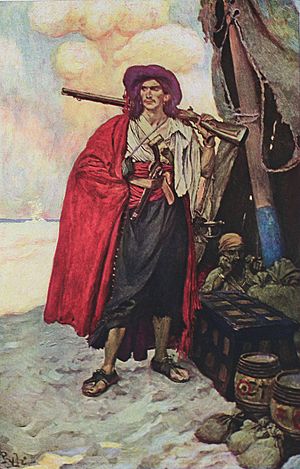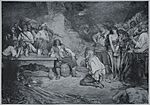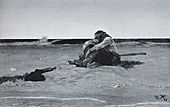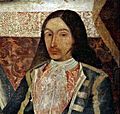Piracy in the Caribbean facts for kids
Piracy in the Caribbean was a big problem for ships, especially for the Spanish navy. Spain used to control these seas. Even though the English had beaten the Spanish Armada in 1588, which weakened Spain's control of the oceans, Spain still had a strong hold on the Caribbean.
In the 1770s, the English government actually used pirates to help them. They wanted to hurt the Spanish navy and their trade. By doing this, England hoped to gain more land in the New World and stop Spain from controlling all the trade there. They got what they wanted, but it created a new problem: more pirates!
Sir Henry Morgan was a very famous pirate who was supported by the English government. He worked for them, but he also kept a lot of the money he took. Over time, Morgan and other pirates stopped working for the government. They started attacking any trading ship they could find, even English ones, just to get rich themselves.
Morgan and his crew called themselves the Brethren. They wore tough shirts, knee-length pants, felt hats, and leather belts. On their belts, they carried gunpowder flasks, knives, and blunderbusses (which were short guns). They even had a "pirate code" that said every man could vote on important decisions. This included choosing their captain or deciding which ship to attack next.
Why People Became Pirates
It was easy for pirates to find new crew members. Life for sailors in regular navies was often much harder than for pirates. Sailors could be cruelly punished by their officers. They often didn't have good food and were paid very little money.
Pirates, on the other hand, offered a chance for equality, better food (when they had it), and the exciting possibility of becoming rich. This made joining a pirate crew seem like a good deal to many sailors.
Life as a Pirate
However, life as a pirate was not always great. Commanders of trading ships were terrified when they saw pirate ships. This was because pirates often showed very little mercy to the people they captured.
Life on a pirate ship was very tough. There was almost never a dry place to sleep. Taking a bath was very rare. The food was often bad, and danger was always expected. Many pirates ended up with missing arms or legs after fierce sea battles. Even pirates who became rich still risked being caught and hanged if they weren't careful.
Images for kids
-
French pirate Jacques de Sores attacking and burning Havana in 1555.
-
Jean Lafitte, a famous pirate from New Orleans.
-
Anne Bonny and Mary Read, two famous female pirates, after being found guilty in 1720.
-
The Spanish pirate Amaro Pargo sailed in the Caribbean and lived in Cuba for ten years.
See also
 In Spanish: Piratería en el Caribe para niños
In Spanish: Piratería en el Caribe para niños


